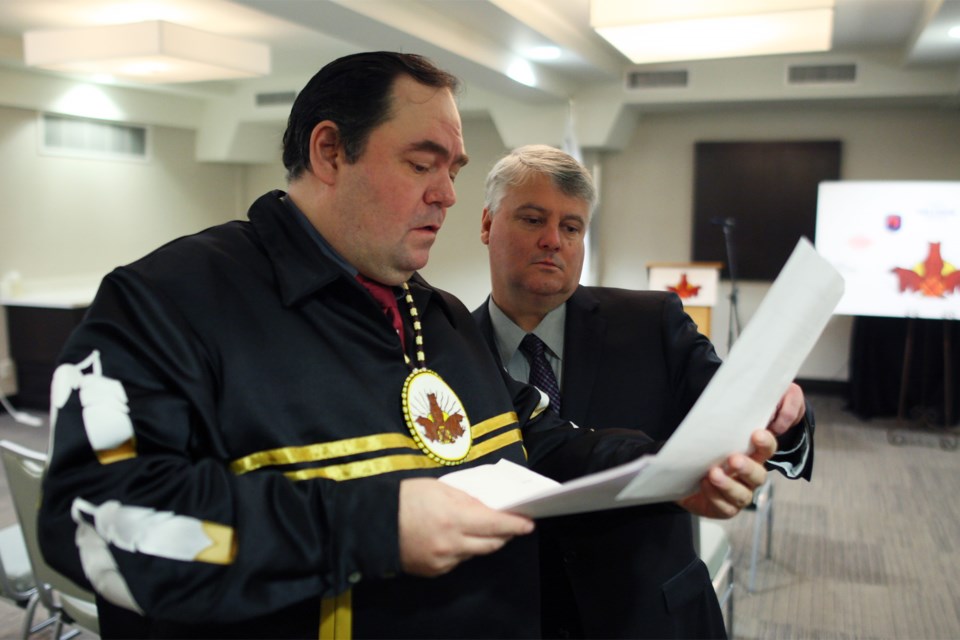A lawsuit filed on behalf of all Treaty 9 First Nations is seeking $10 billion from the Canadian government to increase the annual payments to members, similar to what’s recently been paid out through the landmark Robinson Huron Treaty annuities case.
Last year, Missanabie Cree First Nation Chief Jason Gauthier filed a lawsuit in Sault Ste. Marie on behalf of all 37 Treaty 9 nations through Calgary-based Maurice Law Barristers & Solicitors for an increase in annuity payments, along with a share of mineral rights and considerations for agricultural concerns. The lawsuit was filed against the federal government through the Attorney General of Canada.
The lawsuit is seeking $10 billion "or such other amount as this Honourable Court deems just."
Treaty 9 was signed in 1905 and 1906 between First Nations, the Canadian government and the provincial government. In 1929 and 1930, adhesions were made to it.
The James Bay Treaty covers 90,000 square miles in Northern Ontario. It includes Timmins, which is situated on the traditional lands of Mattagami First Nation. For Indigenous people, it promised $4 each annually. The annual payment remains the same today.
Under the Robinson Huron Treaty, members also received $4 a year.
After years before the courts and an appeal that went to the Supreme Court, Robinson Huron Treaty members negotiated a $10 billion settlement with the Ontario and Canadian governments. Much of that money has begun to flow to members of the 21 nations within the treaty territory, including Garden River First Nation and Batchewana First Nation.
The intent is to address the government's lack of increases paid to each band member since the treaty was negotiated. Lawyers argued the $4 per year payments for each person should have increased with the cost of inflation, along with other considerations.
In a statement of claim filed for the Treaty 9 lawsuit, Gauthier and the First Nations claim the Crown has failed to increase, index or augment annual payment amounts to members.
"In so doing, the Crown has been unjustly enriched at the expense of the First Nation signatories to Treaty 9 and, in particular, the individual Indian recipients of the Annuity Payments, who have suffered a corresponding deprivation," the claim argues.
The claim also says the Crown failed to include provisions for agricultural benefits and assistance, as well as failing to protect the First Nations’ interests in the mineral rights on their reserves.
When it was presented in 1905 and 1906, the treaty was not translated into Anishinaabe or Cree and "the Bands did not have any independent legal or financial advice to assist them in making a full, prior, and informed decision to consent to the terms offered by the Crown."
As a result, the lawsuit alleges the government negotiated in bad faith and "approved and consented to Treaty 9 on terms which were foolish, improvident, and otherwise amounted to exploitation."
"The Plaintiffs claim that the Crown took undue advantage of the isolated and remote Indian Bands of Treaty 9 when it offered them significantly less benefits than the signatories to virtually every one of the numbered Treaties that preceded and followed Treaty 9 received," said the claim.
Last year, a coalition of Treaty 9 First Nations launched a lawsuit against the federal and provincial governments that could have massive implications for the future of resource extraction and Crown-Indigenous relations in Ontario and Canada. It also seeks a $95 billion compensation package to be paid by the federal and provincial governments.
The claim asks the courts to nullify permits, approvals or authorizations granted by Ontario and Canada after the claim is officially filed under 12 laws related to mining, fishery, forestry, planning, water management, and environmental oversight within the treaty territory. Seven are Ontario-specific laws, including the Mining Act, Planning Act, Environmental Assessment Act, and more.
The Treaty 9 First Nations are: Aroland, Attawapiskat, Bearskin Lake, Brunswick House, Cat Lake, Chapleau Cree, Chapleau Ojibway, Constance Lake, Conseil de la Première Nation Abitibiwinni, Eabametoong, Flying Post, Fort Albany (signed as part of Albany), Fort Severn, Ginoogaming, Kasabonika Lake, Kashechewan (signed as part of Albany), Kingfisher, Kitchenuhmaykoosib Inninuwug, Martin Falls, Matachewan, Mattagami, Mishkeegogamang, Missanabie Cree, Moose Cree, Muskrat Dam Lake, Neskantaga, Nibinamik, North Caribou Lake, Sachigo Lake, Slate Falls Nation, Taykwa Tagamou Nation, Wahgoshig (now Apitipi Anicinapek), Wapekeka, Wawakapewin, Webequie, Weenusk (Peawanuck), and Wunnumin.
— with files from Maija Hoggett
